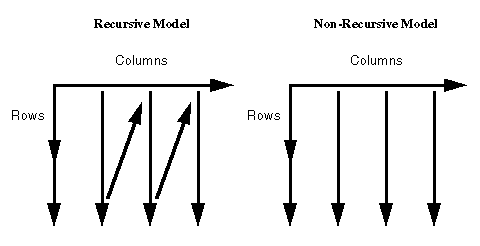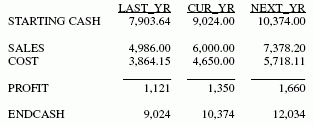
Models involving different time periods often require using the ending value of one time period as the starting value for the next. The calculations describing these situations have two characteristics:
Recursive models require that the columns are produced in sequential order, one by one. In nonrecursive models, all of the columns can be produced simultaneously. Schematically, these patterns are shown as follows.

FML automatically switches to sequential order as soon as either of the two modeling conditions requiring the switch is recognized (either reuse of labels by different rows, or forward reference to a label in a calculation).
The following example illustrates recursive models. Note that one year of ENDCASH becomes the next year of STARTING CASH.
DEFINE FILE REGION CUR_YR=E_ACTUAL; LAST_YR=.831*CUR_YR; NEXT_YR=1.2297*CUR_YR; END TABLE FILE REGION SUM LAST_YR CUR_YR NEXT_YR FOR ACCOUNT 10$$ AS 'STARTING CASH' LABEL STCASH OVER RECAP STCASH(2,*) = ENDCASH(*-1); OVER " " OVER 3000 AS 'SALES' LABEL SLS OVER 3100 AS 'COST' LABEL COST OVER BAR OVER RECAP PROFIT/I5C = SLS - COST; OVER " " OVER RECAP ENDCASH/I5C = STCASH + PROFIT; END
The output is shown as follows.

| WebFOCUS |